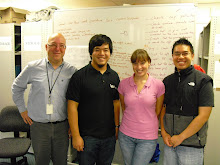Hi everyone. Alot has happened since I last wrote for the blog. The year is now 2011 so I guess you’ve been wondering what we’ve been up to? Well, we've been very busy . . .
A very major part of our project was to attempt to increase the scale of the work as much as possible. So instead of making pieces that are 14x14cm, we want to get to 1x1m or larger. I really think that the size of the artwork will be the first thing that will capture our audience and draw them in. While the small pieces were successful, you had to have a little bit of patience and a good eye to see the movement sometimes.
So that brings me to the creation of the rig. This is a tool or machine that will enable the VHB to be stretched to the size that we want. We had been using a small rig, so logic dictates that in order to make a 1x1m work, we needed a bigger rig! After several months of design, fabrication and construction, we finally have our beautiful rig.
Kit next to the rig while still under construction.
So many people are intrigued in the rig alone purely because it looks so unusual. To begin with, alot of the people at the lab at IRL thought the rig was the artwork! At least that’s what they thought until they saw me use the rig and saw the action and purpose it has.
It is such a great tool and it has already successfully allowed me to create larger work. One of our goals has definitely been achieved already! At the moment, I am encountering issues trying to get the VHB to stretch out past 50cm. I have broken so much VHB eek! Although, I have been experimenting with different sizes, seeing how much I could stretch a very small 7x7cm piece, and then 15x15cm piece. Alot of it comes down to the skill of knowing when to stop, when to adjust certain parts of the VHB or the arms. Now I have some 30x30cm VHB so this will be the type that makes it to 1x1m frame size.
I am also using different methods to ensure the material sticks to the bolts on the arms. I bought some great magnets to try to hold everything in place so I hope this method works out. I need to do some more experimenting with them now. In the photo above you can just see them stuck to the bolts on the edge of the arms, holding the edge of the VHB in place.
Rig and view of the crank handle on the right side.
All in all, the rig has been really successful and even though it looks like I am playing the harp or weaving a tapestry, it is fun to use. The rig has a crank handle so I can turn that with one hand while I have the other hand ready to fix any breakages or tears that occur. How useful.











